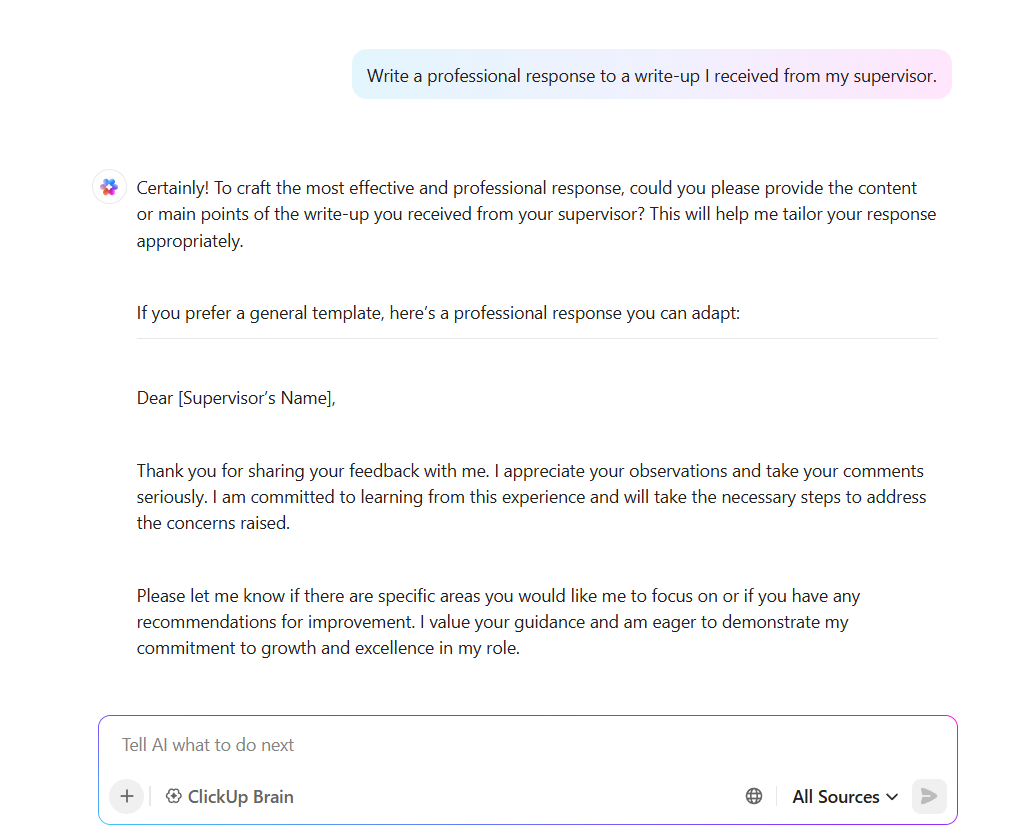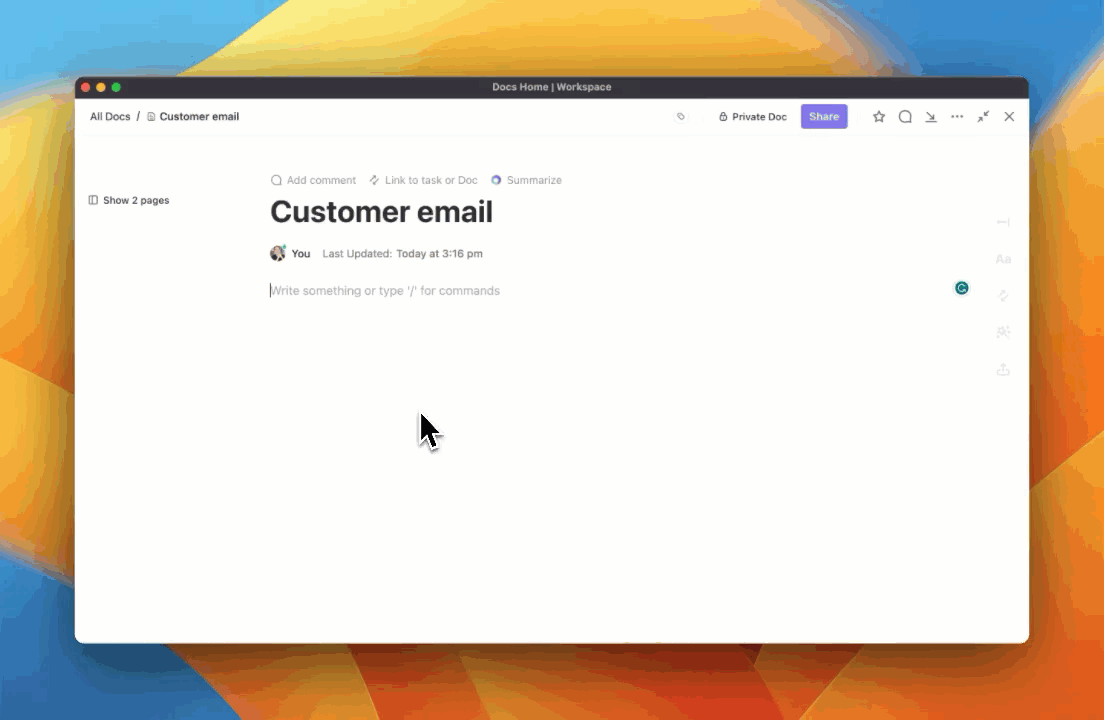Maintaining high standards of performance and conduct is crucial for maintaining a productive and respectful work environment.
Workplace write-ups play a vital role in this process. These disciplinary documents are used when an employee’s behavior or performance falls short of company expectations and policies.
The difference between a warning and a write-up is that a warning is an informal alert about a problem. In contrast, a write-up is a formal record of disciplinary action taken when the issue persists.
Handling this experience professionally and responsibly is critical for those who have received a write-up. Read on as we discuss how to respond effectively and turn the situation into a chance for growth and improvement.
Understanding Write-Ups at Work
Write-ups at work essentially refer to disciplinary documents issued by an employer when an employee’s behavior or performance fails to meet company standards. An employee write-up formally addresses issues, outlines expectations for improvement, and guides employees in correcting their performance issues or conduct. This can be a process of progressive discipline.
Employers generally use performance review templates and software tools to create detailed Performance improvement plans (PIPs), which help employees understand what they need to improve their poor performance.
An employer can issue several types of write-ups to create a paper trail. Each write-up is an escalation of the previous one in the situation where the first warnings go unaddressed and aims to implement progressive discipline:
- Verbal warning: This is a private conversation where a manager addresses poor performance or conduct issues with the employee. This verbal warning serves as the first informal alert
- Written warning: A formal document detailing specific issues and outlining the company’s expectations for improvement can follow the verbal warnings and will be part of the employee’s file
- Performance improvement plan (PIP): A comprehensive document that includes a detailed plan to help the employee improve their performance and conduct
Read more: Performance review tips for employees
Impact and role of write-ups
Here’s a snapshot of the impact and role of employee write-ups in the workplace:
- Termination: Write-ups serve as documented evidence of unprofessional behavior. If issues are not addressed, they can contribute to grounds for termination
- Legal protection: They provide legal protection for employers by demonstrating that proper steps were taken to address the employee’s behavior, which can justify termination if necessary
- Workplace discipline: Write-ups are part of a consistent disciplinary process, ensuring that all employees are treated fairly and uniformly
- Warning: For employees, write-ups are a chance to correct their behavior or performance while there is still an opportunity to improve and retain their job
If an employee fails to address the issues raised in the write-up process, it can lead to termination and impact future job prospects, as these issues may arise in future interviews. In such cases, it is critical to remain calm, understand how to react to a write-up, and focus on improving performance and conduct.
However, you must avoid micromanagement, which can heighten tensions and lead to employee dissatisfaction. Micromanaging can cause employees to feel undervalued and excessively monitored, negatively affecting their performance and overall morale.
Common reasons for write-ups
Here are some reasons that may lead to receiving a formal document like a write-up at work:
- Tardiness: Regular lateness can prompt disciplinary notice, as punctuality is crucial for workplace efficiency. It can also disrupt team operations and impact overall productivity
- Discrimination: All employees at a workplace deserve equitable treatment and mutual respect, which is part of company policies. If you have been participating in discriminatory acts on any grounds, you may be put through disciplinary action
- Low performance: Companies expect their employees to deliver a bare minimum standard of work so as not to disrupt business operations. If you haven’t been able to meet this requirement, you may receive a write-up
- Misconduct: Professionalism is fundamental in the workplace and is part of your job performance. If your behavior violates company policies or involves harmful actions, such as theft of company property, you may receive a write-up
- Harassment: Harassing colleagues or others at work compromises a positive work environment, is in contradiction with your employment contract, and invites disciplinary measures
- Insubordination: A clear hierarchy in an organization helps delegate work and establish accountability, which is part of the company policy. Failing to follow reasonable, rational instructions may get you a notice of discipline
Most workplace disciplinary actions can be avoided if employees follow company policy and maintain professionalism, such as setting up ‘Out of Office’ messages during absences, responding correctly to queries, maintaining work standards, etc.
How to Respond to a Write-Up at Work?
Receiving a formal write-up at work can be a stressful experience, especially with the potential risk of termination and uncertainty about your next job. However, despite what write-ups represent, it is critical to stay calm in these situations and respond appropriately.
Taking a moment to calm yourself can help in several ways:
- Clear thinking: Reduced stress levels can help you think more logically and clearly
- Enhanced understanding: With a calmer mind, you can read and understand the write-up more thoroughly, grasping the reasons behind it
This clarity is crucial, as you need a level head to address the write-up professionally and prepare an effective response.
A step-by-step guide to responding to a write-up
1. Assess the situation
Staying calm in such situations is crucial. Once you’ve calmed down, thoroughly review the write-up document. Identify and note each concern or issue mentioned, treating each as an opportunity for improvement rather than a personal attack. This will help you focus on the areas you must address and understand if you require additional training.
2. Seek clarification
If any parts of the write-up are unclear or unreasonable, professionally seek clarification from the issuer or your manager. Schedule a meeting to discuss the write-up and prepare clarifying questions such as:
- Could you clarify where my performance fell short of expectations?
- How can I better align my work with team goals?
- Are there specific areas where I need to improve? For example, if the write-up cites behavioral issues, ask for more details on the same
This way, you can avoid misunderstandings, address all concerns accurately, and demonstrate your commitment to resolving the issues effectively.
3. Write a professional response
Once you’ve fully understood the write-up, follow these steps to craft a professional response:
- Gather documentation: Collect all relevant documents and evidence related to the issues cited, including emails, performance records, reports, and project documents
- Onboard witnesses: If applicable, list any witnesses who can support your case or provide corroborating evidence
- Draft your rebuttal: Draft a professional and concise response. Address any misunderstandings or misinterpretations with clear facts and evidence

You should also acknowledge your mistakes and accept the disciplinary measures outlined. This approach has two key benefits:
- Demonstrates commitment: It shows the company that you are willing to address the issues, improve your performance, and align with company goals
- Builds your narrative: This helps you frame your response constructively, reinforcing your readiness to correct the situation and defend your position
4. Follow up
After your review meeting, create a structured plan for the next steps. Schedule a follow-up meeting to maintain open communication with relevant individuals.
Before the follow-up meeting, prepare by:
- Outlining a performance improvement plan: Develop a clear strategy for enhancing your performance
- Monitoring your progress: Set up a system to track your adherence to the disciplinary action and your improvement
- Establishing a feedback loop: Request regular feedback from your supervisors to ensure you’re on track
Review company policies and onboarding documentation to confirm you’re fully informed. This preparation helps you address further concerns and supports your position if the disciplinary action feels disproportionate or unwarranted. It also helps you deal with potential consequences.
Exceptional Cases: Responding to Unfounded Write-ups
If you receive a write-up that seems unfair or vague, addressing it promptly and professionally is essential.
Follow these steps to draft a strong rebuttal while maintaining respect and clarity:
1. Know your rights
Familiarize yourself with the employment laws and regulations that apply to your workplace. For example, the Civil Rights Act of 1964, including Title VII, prevents discrimination in the workplace.
Understanding these laws will help determine if your write-up is legally justified. So, review your employee rights. Ask clarifying questions, and seek advice from a union representative or employment lawyer to address your concerns appropriately.
2. Understand at-will employment
In the U.S., at-will employment means an employer can terminate employment at any time for any reason, as long as it’s not illegal. If your write-up falls into this category, approach your rebuttal with a professional and evidence-based strategy. Consulting with relevant professionals and discussing the situation with your manager can help clarify your position.
3. Gather evidence and voice your objection
Collect evidence that supports your case against the write-up. This might include timesheets, emails, documents, or communications contradicting the allegations. Request statements from colleagues who can attest to your conduct and performance. Build a well-documented case to refute the write-up effectively.
4. Seek legal help if required
If private discussions with your manager or the issuing authority don’t resolve the issue, consider seeking legal counsel. A lawyer can clarify your legal position and guide you through the next steps to address the situation appropriately.
Using Tools to Overcome Workplace Issues
Addressing write-ups at work is critical, and using technological tools can significantly aid in building a solid case, gathering evidence, and crafting a professional response.
Here’s how they can help:
- Centralize communication: Use email and messaging tools to consolidate all related conversations and notifications in one place, ensuring you have a comprehensive record of communications relevant to the write-up
- Organize and plan: Employ project management and planning tools to outline your response strategy, organize evidence, and create a structured plan to address the issues raised
- Document and track evidence: Use document management systems to collect and store all pertinent evidence, such as emails, performance reports, and other relevant documents, for easy access and reference
- Draft professional responses: Leverage document editing and formatting tools to create a clear, concise, and professional response. Tools with templates and formatting options can enhance the quality of your written communication
- Monitor and review progress: Implement tracking tools to monitor your progress in addressing the issues, set reminders for follow-up actions, and ensure you stay aligned with any commitments or improvement plans
On this note, ClickUp is a comprehensive solution for enhancing workplace communication and collaboration.
Here’s how it helps:
1. Streamline email management

With ClickUp Email Management, you can send and receive emails directly from tasks, keeping all related conversations organized in one place. This feature makes it easy to track and manage all email threads associated with the write-up.
Additionally, it allows you to add attachments, forms, responses, signatures, and other necessary documents to email threads, providing a streamlined and official approach to handling the write-up.
📮 ClickUp Insight: 1 in 4 employees uses four or more tools just to build context at work. A key detail might be buried in an email, expanded in a Slack thread, and documented in a separate tool, forcing teams to waste time hunting for information instead of getting work done.
ClickUp converges your entire workflow into one unified platform. With features like ClickUp Email Project Management, ClickUp Chat, ClickUp Docs, and ClickUp Brain, everything stays connected, synced, and instantly accessible. Say goodbye to “work about work” and reclaim your productive time.
💫 Real Results: Teams are able to reclaim 5+ hours every week using ClickUp—that’s over 250 hours annually per person—by eliminating outdated knowledge management processes. Imagine what your team could create with an extra week of productivity every quarter!
2. Organize and collaborate with whiteboards

ClickUp Whiteboards improves collaboration by letting everyone see and contribute to the same visual workspace in real-time. You can easily share a public link for client or stakeholder feedback. Just share the Whiteboard URL for project meetings to enable working together effectively.
It also helps organize strategies and brainstorm ideas for your write-up, allowing you to draw, add notes, and connect your thoughts visually.
3. Facilitate real-time collaboration

ClickUp Chat View allows you to collaborate in real-time with team members while keeping everything in one place. This feature integrates conversations and resources, minimizing the need to switch between multiple tools.
Here’s how it can help you write a response to a write-up at work:
- Keep all discussions and updates about the write-up in one place, reducing the need to juggle multiple tools and minimizing distractions
- Collaborate with team members in real-time, allowing for immediate feedback and support, which helps manage stress and maintain clarity
- Use chat channels to structure your response by linking relevant resources and assigning tasks, ensuring all points are addressed systematically
- Share and track progress on the response directly within the chat, keeping all related information and revisions in a single, accessible location
4. Create and manage documents efficiently

ClickUp Docs helps you effortlessly draft your write-up response. This versatile tool allows you to create various documents and seamlessly integrate them with your workflows, ideas, and outputs. You can customize your documents with styling options, templates, bookmarks, tables, and more.
Additionally, ClickUp Brain helps teams save time and stay focused by minimizing meetings, delivering quick summaries, and automating tasks. It provides insights on conveying ideas concisely, professionally, and persuasively.

Read more: The power of ClickUp Forms
Optimize Your Write-Ups and Workflows with ClickUp
Challenges are part of every job, and write-ups offer a chance for personal and professional growth. In this regard, ClickUp is a crucial tool for streamlining your process.
ClickUp consolidates digital evidence and supportive resources in one place, ensuring efficient management and enhanced collaboration. Whether drafting responses, managing tasks, or coordinating with your team, ClickUp simplifies and strengthens your workflow.
Don’t wait any longer—sign up on ClickUp and revolutionize the way you work today!



